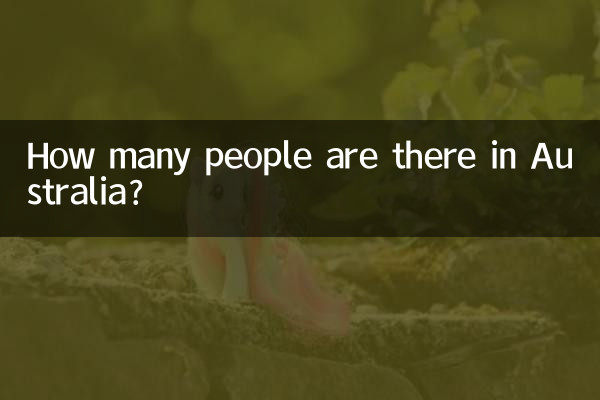Australia’s population: latest data and hot spot analysis
In recent years, Australia's demographic changes have been one of the focuses of global attention. Based on the latest statistics and hot topics in the past 10 days, this article will present you with detailed information about Australia's population from the aspects of total population, growth rate, immigration trends, and distribution among states.
1. Total population of Australia (latest data in 2024)

| index | data |
|---|---|
| total population | 26,821,557 people |
| male population | 13,189,667 people |
| female population | 13,631,890 people |
| population growth rate | 1.4% |
| population density | 3.4 people/square kilometer |
2. Population distribution by state and territory
| State/Territory | Population | Proportion of total population |
|---|---|---|
| new south wales | 8,307,500 | 31.0% |
| victoria | 6,811,000 | 25.4% |
| Queensland | 5,353,800 | 20.0% |
| Western Australia | 2,875,200 | 10.7% |
| south australia | 1,815,500 | 6.8% |
| Tasmania | 572,800 | 2.1% |
| Australian Capital Territory | 462,200 | 1.7% |
| Northern Territory | 250,600 | 0.9% |
3. Analysis of population growth hotspots
Australia’s recent population growth is mainly affected by the following factors:
1)Immigration surges again: With the implementation of the open border policy, Australia's net overseas migration reached a record high of 510,000 people in the 2023-24 fiscal year, becoming the main driver of population growth.
2)Fertility rate rebounds: Australia's total fertility rate rebounded from 1.58 in 2020 to 1.66 in 2023, reflecting the "fertility rebound" phenomenon in the post-epidemic era.
3)Regional migration trends: Data shows that more and more Australians are choosing to move from big cities to regions such as Queensland and Tasmania in search of lower living costs and better quality of life.
4. Changes in age structure
| age group | Population | Proportion of total population |
|---|---|---|
| 0-14 years old | 4,857,200 | 18.1% |
| 15-64 years old | 17,062,300 | 63.6% |
| 65 years and above | 4,902,100 | 18.3% |
5. Population ranking of the top ten cities
| Ranking | City | population |
|---|---|---|
| 1 | Sydney | 5,367,200 |
| 2 | Melbourne | 5,159,200 |
| 3 | brisbane | 2,560,700 |
| 4 | Perth | 2,143,800 |
| 5 | adelaide | 1,376,600 |
| 6 | gold coast | 716,000 |
| 7 | Newcastle | 505,400 |
| 8 | Canberra | 462,200 |
| 9 | sunshine coast | 348,300 |
| 10 | Wollongong | 307,000 |
6. Recent hot topics
1)housing crisis: Rapid population growth has caused Australia's major cities to face serious housing shortages, with rents and house prices continuing to rise.
2)Immigration policy adjustments: The Australian government announced that it will tighten requirements for certain visa categories to cope with infrastructure pressure caused by rapid population growth.
3)Aboriginal population growth: Australia’s Aboriginal and Torres Strait Islander population reached 897,000, accounting for 3.3% of the total population, with a growth rate higher than the national average.
4)Aging Challenges: The proportion of the population over 65 years old continues to rise, and is expected to reach 22% by 2031, putting huge pressure on the medical and elderly care systems.
Conclusion
Australia's population development is characterized by diversification, urbanization and aging. Australia's demographic structure will change significantly in the coming years as immigration policies adjust and fertility patterns change. These changes will profoundly affect Australia's economy, society and policy making and deserve continued attention.

check the details

check the details